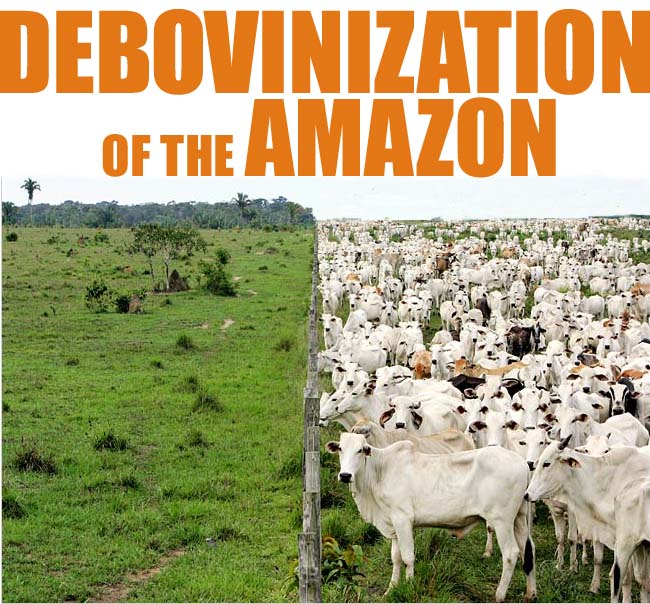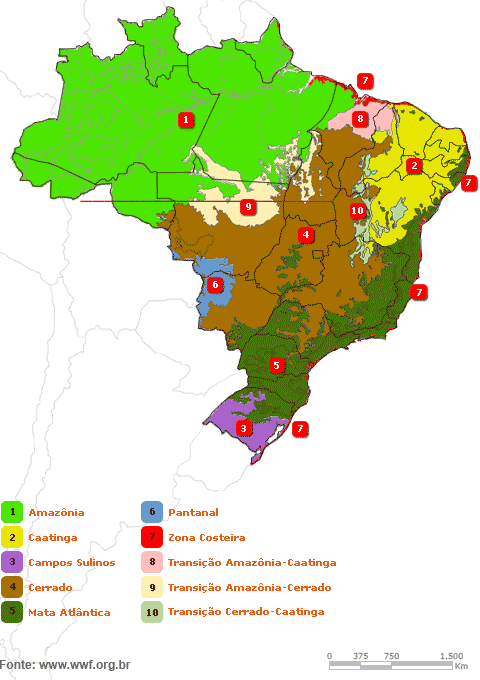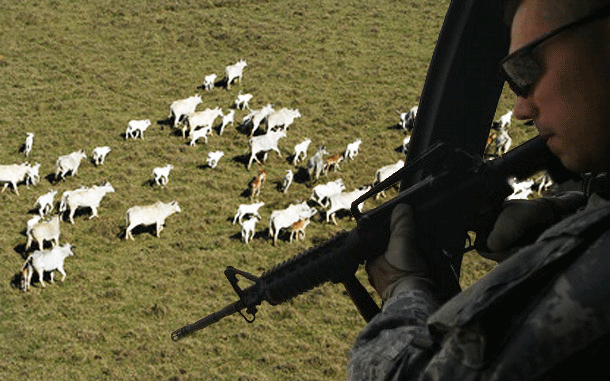
Debovinization of the Amazon
Giant fence will protect Amazon from cattle Reuters - On January 1, 2010 the Brazilian government will begin construction of a 2040 kilometer fence to protect the Amazon rainforest from the expansion of pastures. The barbed wire fence will begin 25 km south of Guajará-Mirim on the Brazilian border of Mato Grosso with Bolivia and will extend eastward 2040 kms to the border of the State of Bahia with the State of Tocantins in Formosa do Rio Preto. Construction is planned to take 7 months. Entities involved in construction are the Brazilian Ministry of Environment, IBAMA (The Brazilian Institute for Environment and Renewable Resources), FUNAI (The National Indian Foundation), (INPE) the Institute for Brazilian Space Research, the Brazilian Armed Forces and one company to be determined by a public bid to take place in 2010. |

The Brazilians plan a cull of all bovine species north of the fence. The goal is to shoot all cattle in 1000 square kilometers of pastures every month. (1000 square kilometers is the amount of jungle lost to burning every month; enough trees to cover the city of Rio de Janeiro). "The government wants to adopt a policy of 'reversability' and not just sustainability", says spokesperson for the project Ricardo Jorge. "In order to save the Amazon Rainforest the amount reclaimed from cattle per month must exceed the amount cut down or burned every month to give way to pastures". The project is named Project Tordesilhas after the treaty line that partitioned South America between the Portuguese and Spanish crowns during the 15th Century. "Every cow and bull north of this fence will be sacrificied," informed spokesperson Ricardo Jorge. It is estimated that 73 million cattle exist in this region. The massive cull of Amazonian cattle will take place from air via helicopters. Safaris will even be offered to eco-tourists interested in shooting cattle to save the forest. The same helicopters that will carry the gunmen will also drop seeds of native tree species in an attempt to restore the forest over time.
In addition, the University of the Amazon (Universidade da Amazônia or UNAMA) as well as all universities in the region will qualify to receive support from UNEP (United Nations Environment Programme) and the CNPq (Brazil's National Council of Scientific Development) for developing and implementing replanting techniques and soil restoration of devastated areas. Converting pastures to soy plantations or any other cash crop will be strictly prohibited. The choice of location for the fence: The Tordesilhas Fence will run along parallel 11 and will bisect an important ecosystem the size of England in the northern region of Mato Grosso and Southern portion of the State of Pará (see number 9 below). This region is a unique transitional vegetation system from rainforest to Cerrado (the Brazilian Savannah). The fence will protect 50 percent of this ecosystem and will only be built in areas of existing farmland and burned areas along the 2040 kilometer line. In uninhabited areas the fence will be a virtual one watched over by The Institute for Brazilian Space Research in collaboration with the Armed Forces. The fence will not be built within the 5 indian reservations through which the virtual line runs. |

It is not the first time fences are used to contain European species introduced into the New World. In Australia, for example, fences thousands of kilometers long have been put up (and still exist) to keep rabbits from spreading west. Grazing and burrowing by rabbits have caused serious erosion problems and threatened the survival of native plants and animals by modifying entire landscapes. For this reason Australians have put up a number of "Rabbit Fences". Introducing cattle into the Amazon has had an even more disastrous effect than the European rabbit in Australia. In order to create cattle habitat, farmers not only annihilate existing rainforest but burn it sending fires out of control far beyond the amount of land they will use thus pumping massive amounts of climate-changing carbon into the atmosphere. Sovereignty: With the exception of United Nations contributions to academic research in replanting the forest, the Brazilian government intends to refuse any foreign aid for the project in order to maintain sovereignty over the Brazilian Amazon, says Environment Spokesperson Ricardo Jorge. "We are engaging in a new sort of Treaty of Tordesilhas, not with a foreign force but with ourselves. We want to act globally responsible in order to save a treasure that is primarily ours; a feat we are sure the whole world will applaud." - Reuters |

Cattle is not compatible with the survival of the Amazon Rainforest. Period.
Cows will be prohibited to enter the Amazon. Period.
Debovinization of Amazonia, Now!
